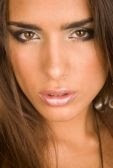 Tip 1: Coloring newbie? Start with a semipermanent color. Semipermanent colors wash out after a few washes, whereas permanent colors never wash out. If you are new to coloring your hair, you might start with a semipermanent hue UNLESS you want to cover gray hair or go two or more shades lighter or darker.
Tip 1: Coloring newbie? Start with a semipermanent color. Semipermanent colors wash out after a few washes, whereas permanent colors never wash out. If you are new to coloring your hair, you might start with a semipermanent hue UNLESS you want to cover gray hair or go two or more shades lighter or darker.Tip 2: Don't go by the picture on the box Pictures on hair color boxes can be deceiving. Your better off going by the color swatches on the box and the descriptions. According to the February 2006 issue of Ladies Home Journal, most boxes will call out the color (blonde, brown, black and red) and the shade of that color (light, medium and dark). There might also be mention of the tone (golden or ashy).
Tip 3: Is your skin color warm or cool? Most hair colors fall into either 'warm' or 'cool' families. You're likely a 'warm' if you have golden, olive or dark skin and brown or dark eyes (most Latinas, Asians and African Americans fall into this category). You tan easily and the veins in your inner wrists are green. You're a 'cool' if you have fair skin and blue or green eyes. You burn before you tan and the veins in your wrists run blue. If you're confused because you sometimes burn, sometimes tan, you likely skew warm.
Tip 4: Choose the correct shade If you have warm skin, opt for golden shades such as caramel and bronze in a darker shade than your skin. Avoid jet-black hair which will wash you out and if you do opt for a golden shade, don't go too light or your hair could turn orange. If you have cool shade, avoid colors that will highlight the ruddiness of your skin tone: Gold, auburn and copper. Ash blondes and cool browns work best.
Tip 5: How to tell if you'd make a great blonde A basic rule of thumb: People who had blonde hair as children have the right skin tone to be blonde adults.
Tip 6: The right shade of blonde Brassy blonde color or highlights on someone with a warm skin tone can be harsh. Opt for warmer shades instead. If you have brown hair and want to go blonde, you don't want to go too light or you could look washed out. Opt for contrast: Highlights and lowlights. And keep in mind that darker hair will actually complement brown or green eyes better than blonde hair.
Tip 7: When to go red Almost everyone can go red, what's most important is finding the right shade to complement your skin color. Women with a cool or pink skin tone pull off red best, according to Jennifer J, a stylist quoted in the February 2006 issue of Marie Claire.
Tip 8: How to hide that gray Gray hair can be hard to color because of its coarse texture. If your hair is less than one-thirds gray, opt for a semi-permanent color that's a shade lighter than your natural color (or matches your color). The gray will blend right in. Semi-permanent color is less damaging than permanent color. If your hair is more gray, colorist Rita Hazan in the November 2004 issue of InStyle magazine, suggests a permanent 'ashy' color, which will help your gray hair appear blonde.
Tip 9: Uh-oh, the color's all wrong I strongly suggest you seek out professional help if you dye job went wrong. Coloring over color can be tricky and you don't want to overprocess your hair.
Tip 10: Don't go extreme At-home coloring is best for people looking to go a couple shades lighter or darker or to cover gray. If you have light brown hair, a dark blonde will look beautiful on you. For extreme changes, it's best to seek out the help of a professional rather than trying to dye your dark brown hair light blonde.




0 comment:
Post a Comment